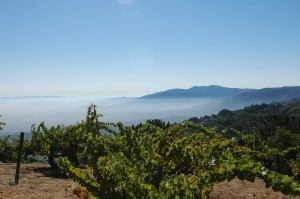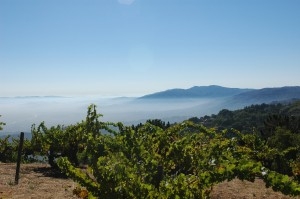Ridge Vineyards: Uncompromising Quality
The history of Ridge Vineyards begins in 1885, when Osea Perrone, a doctor who became a prominent member of San Francisco's Italian community, bought 180 acres near the top of Monte Bello Ridge. He terraced the slopes and planted vineyards; using native limestone, he constructed the Monte Bello Winery, producing the first vintage under that name in 1892. This unique cellar, built into the mountainside on three levels, is Ridge's production facility.
The first Zinfandel was made in 1964, from a small 19th Century vineyard farther down the ridge. This was followed in 1966 by the first Geyserville Zinfandel. The founding families reclaimed the Monte Bello terraces, increasing vineyard size from 15 to 45 acres. Working on weekends, they made wines of regional character and unprecedented intensity.
By 1968, production had increased to just fewer than 3,000 cases per year, and in 1969, Paul Draper joined the partnership. A Stanford graduate in philosophy, recently returned from setting up a winery in Chile's coast range, Paul was a practical winemaker, not an enologist. His knowledge of fine wines and traditional methods complemented the straightforward "hands off" approach pioneered at Ridge. Under his guidance, the old Perrone winery (acquired the previous year) was restored; the finest vineyard lands leased or purchased, and the consistent quality and international reputation of the wines established.
In fact, early on in 1970, the late English wine writer, Harry Waugh, a former director of Chateau Latour, visited Ridge and, on tasting the 1959 Monte Bello, called Ridge "the Chateau Latour of California." I was privileged to have known Harry. He was one of the greatest tasters of all time and one of the most honest. In addition he was a very kind and unpretentious man. He wrote about wine in a way you could understand. Quite unlike the new wave of 100 point boys, whose writing is as extracted and over the top as the wines they profess to love, he was straight from the "what you see is what you get" mold. Harry, to use a play on his own words, was a Latour/Ridge kind of a man. His opinion was widely respected by my friends and I at that time and it is one that continues to this day.
The Ridge Monte Bello (originally Monte Bello Cabernet; until 1975, 100% Cabernet Sauvignon) is the wine that introduced Ridge to the world; and the world to Ridge. Today it is a blend of Bordeaux varietals in which Cabernet Sauvignon still predominates. Exhaustive tasting of test blends during assemblage determines how much, if any, Merlot, Petit Verdot or Cabernet Franc will be included with the Cabernet Sauvignon in the finished wine. Almost every vintage (an unbroken chain from 1962 on) has something substantive to recommend it. Each decade has its high points, but year after year Monte Bello proves to be a consistently outstanding wine, with great structure, complexity and balance. And the wine develops for a very long time.
Ridge Monte Bello's original prominence worldwide came when the 1971 vintage was entered in the famous Judgment of Paris Tasting of 1976. In this blind tasting, it came in 5th out of 10 wines, behind Stag's Leap, Mouton Rothschild, Montrose and Haut-Brion. In the Paris Tasting 30th Anniversary Reenactment that took place in the Napa Valley and in London on May 24, 2006, again in blind tasting format, judges on both continents awarded top honors to the 1971 Ridge Monte Bello.
On a recent visit to Ridge I tasted a wide range of wines both from barrel and bottle. Following is background information on Monte Bello and tasting notes on recent vintages and a few older ones. This is followed by notes on other Ridge wines from recent vintages (including notes on barrel samples and wines to be released September 1), notes on some older Ridge wines, and my concluding remarks.
Click here for more on Ridge Vineyards and tasting notes.
—John Tilson, Underground Wine Letter

